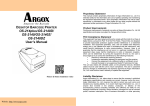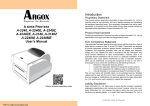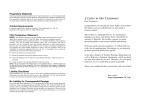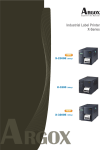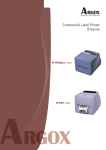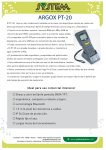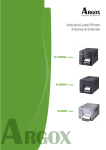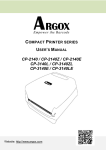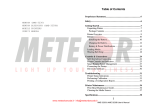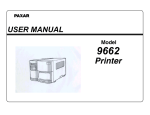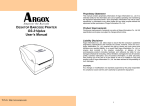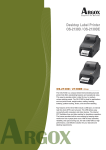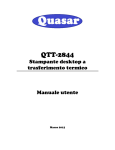Download MJ-2844 User manual - Shenzhen Alacrity Barcode Technology CO
Transcript
Liability Disclaimer DESKTOP BARCODE PRINTER MJ-2844 User’s Manual Alacrity barcode technology takes steps to assure that the company’s published engineering specifications and manuals are correct; however, errors do occur. Alacrity barcode technology reserves the right to correct any such errors and disclaims any resulting liability. In no event shall Alacrity barcode technology or anyone else involved in the creation, production, or delivery of the accompanying product (including hardware and software) be liable for any damages whatsoever (including, without limitation, damages for loss of business profits, business interruption, loss of business information, or other pecuniary loss) arising out of the use of or the results of use of or inability to use such product, even if Alacrity barcode technology has been advised of the possibility of such damages. CAUTION: Any changes or modifications not expressly approved by the party responsible for compliance could void the user's authority to operate the equipment. Product Improvements Continuous improvement of products is a policy of Alacrity barcode technology All specifications and signs are subject to change without notice. I Table of Contents Getting Started ..................................................................3 Package Contents.................................................................... 4 Connecting the Power Supply ................................................. 5 Getting to Know Your Printer ...........................................6 Parts and Features ...................................................................6 Controls and Indicators ........................................................... 9 Loading Ribbon and Media ............................................11 Loading Ribbon .................................................................... 11 Loading Media...................................................................... 16 Calibration and Configuration........................................20 Performing Calibration and Configuration ............................ 20 Resetting to Factory Default Settings .................................... 21 Installing the Printer Driver ............................................22 Troubleshooting ..............................................................32 LED Diagnosis ..................................................................... 32 Miscellaneous ....................................................................... 35 Recovery .............................................................................. 36 Caring for Your Printer....................................................37 Cleaning ............................................................................... 37 Media Sensor ........................................................................ 37 Thermal Print Head ............................................................... 37 Replacing the Thermal Print Head ......................................... 40 Important notice during TPH replacement ................... 42 Technical Reference ....................................................... 43 2 Getting Started Congratulations on choosing the Alacrity desktop barcode printers. This manual will help you get to know your new printer. There are two parts to this manual,an operation guide information. The operation guide is illustrated to help you quickly become familiar with the printer. The related information includes troubleshooting, maintenance and technical information for your reference. 3 Package Contents Connecting the Power Supply Connect the power supply as below. WARNING! Do not operate the printer and power supply in an area where they can get wet. Printer Power Supply Power Cord CD ROM USB Cable Media Holder Make sure the power switch is in the "O" position. 1. Insert the barrel connector of the power supply into the power jack on the back of the printer. Note the location of the power jack for different models in the diagrams below. 2. Insert the separate power cord into the power supply. 3. Plug the other end of the cord into an AC electrical outlet. Note:Pictures for reference only! 4 5 Getting to Know Your Printer The illustrations that follow describe the printer’s parts, features, controls, and indicators. Parts and Features Ribbon Pick-up Holder Top Cover Media Hanger H Cover Power Switch Power Indicator Release Levers Ready Indicator Feed Button 6 7 Controls and Indicators Ribbon Supply Holder Thermal Print head The printer’s controls and indicators are shown in the diagram below. The following table explains control and indicator functions. Platen Roller Top Cover Power Switch Power Indicator Power Switch Ready Indicator Feed Button 8 9 Loading Ribbon and Media Control / Indicator Function This section describes how to load ribbon and media in printer. On: turns on normal operation Power Switch Off: turns off power Note: Turn power off before connecting or disconnecting cables Loading Ribbon Note: This section does not apply to direct thermal printing. Green light shows the power-on Power Indicator Light off shows the power-off Blinking light indicates error has occurred Green shows printer is ready to operate Ready Indicator 1. Lift the top cover to expose the media compartment. 2. Unlatch the print head module by pushing the two white release levers on the sides toward the rear. 3. Turn over the print head module to expose the ribbon supply holder. Blinking light indicates printer is paused or data transferring Seagull driver status monitor Press to advance labels to the first printing position Feed Button Press to take the printer out of "pause" Press and hold while turning on the power to print out a configuration profile 10 11 Media Compartment Print Head Module Release Lever Release Lever 4. Unwrap the ribbon roll pack and separate the ribbon roll and the bare core. 5. Attach the edge of the ribbon on the bare core and wind it a little bit onto the core. 6. Insert the ribbon roll into the supply holder. (First snap in the left side and then the right side.) Ribbon Supply Holder Ribbon Supply Holder Ribbon Roll Bare Core 12 13 7. Turn back the print head module and then insert the bare core into the pick-up holder. (First snap in the left side, and then the right side.) 8. Turn the wheel of the print head module to ensure the ribbon is tightly wound. 9. Press down the print head module firmly until you hear a snap. Wheel Ribbon Pick-up Holder Bare Core Print Head Module 14 15 2. Remove the media hanger. Loading Media 1. Lift the top cover to expose the media compartment. Media Compartment Media Hanger 3. Load the media roll onto the hanger from left to right. Media Roll Media Hanger 16 17 4. Click the media hanger back into the media compartment. 5. Align the media roll to the left end. 6. Move the shield from right to left until it leans against the media. 7. Unlatch the print head module. 8. Hold the print head module upright with one hand to allow the media to pass under it. Lead the media through the media guides with the other hand. 9. Lead the media over the platen roller. Media Compartment Print Head Module Media Guides Media Roll Shield 18 10. Put the print head module down and press down firmly until you hear a snap. 11. Close the top cover and turn on the printer or press the "FEED" button if the printer is already on. 19 Calibration and Configuration This section discusses calibration, printing configuration and resetting the printer to factory defaults. Performing Calibration and Configuration 1. 2. 3. 4. 5. Turn off the printer power. Press and hold the feed button while turning on the power, until the printing motor is activated. Calibration is performed while the printer automatically feeds the label stock for a certain length, the printing motor suspends for one second and then prints out a configuration profile. The profile includes firmware version, ROM checksum, RS-232, thermal transfer/direct thermal settings, hardware configuration, and font types. At PPLB emulation, the printer enters character dump mode. To exit from dump mode, press the feed button again. (If you accidentally print the label without exiting from dump mode in advance, you need to turn on the printer or press feed button again to print normally.) Resetting to Factory Default Settings 1. Turn on the printer and wait for 5 or more seconds. 2. Press the "Feed" button for 10 seconds, and the "Ready" indicator and "Power" indicator will go off in order. 3. When the two indicators relight, release the feed button. 4. The printer feeds approximately 3 ~5 blank labels, and then resets to the factory defaults. Note: Revise the factory default settings that stored in flash, even if turn off the power source cannot be eliminated. Important! You must always carry out calibration when changing media. Failure to do so will result in improper detection by the label sensor. 20 21 Installing the Printer Driver 1. Turn off the printer. Plug the power cable into the power socket on the wall, and then connect the other end of the cable to printer's power socket. Connect the USB cable to the proper port on the printer and on your computer. 4. Assign the directory to keep driver, (for example:C:\Seagull) and click "Next". 2. Prepare the documentation and software CD-Rom from printer package and then install to CD-Rom drive of your computer. 3. Select “I accept…”and click "Next ". 22 23 5. Click "Finish". 6. Select Install printer drivers and Click "Next" 24 25 7. Select model & emulation - the following examples are based on model OS-214 plus PPLA 8. Select the port of the printer and click "Next". Argox OS-2140 PPLA A rgox OS-2140 PPLA A rgox OS-214 plus PPLA A rgox OS-2140 PPLA 26 27 9 . Enter Printer name (i.e. Argox OS-214 plus PPLA) and select "do not share this printer”, and click "Next". Argox OS-214 plus PPLA Argox OS-2140 PPLA 10. Check all the data on the showing screen, if it is correct, click "Finish". Argox OS-214 plus PPLA USB001 Argox OS-214 plus PPLA 7.1.9_M-5 28 29 11. After the related files have been copied to your system, click "Finish". 12. After driver installation is complete, click "Close". The driver should now be installed. Installed printer Argox OS-214 plus PPLA Installing printer ‘Argox OS-214 plus PPLA’… 30 31 Troubleshooting Normally, when the printer is in not working properly, the "Power" LED blinks continuously; while printing and communication between the host and printer stops. LED Diagnosis Power and Ready LEDs blinking continuously indicates printer errors. To understand the problem, please observe the Power and Ready LEDs and refer to the following solutions: LED Indicators: Power and Ready LEDs blink alternately Power LED ON OFF Ready LED OFF ON Possible Problems Solutions Ribbon out Supply the ribbon roll Ribbon jam Recover the jam Ribbon sensor error Replace ribbon sensor Remarks Not applicable to direct thermal type. LED Indicators: Power and Ready LEDs blink at the same tempo LED Indicators: Only the Power LED blinks Power LED ON OFF Ready LED ON OFF Power LED Ready LED ON ON OFF ON Possible Problems Solutions Remarks If you use a Miss-detect gap Check the label path Check the label sensor continuous label roll and run under Windows, select continuous media. Label stock out Supply the label roll Label stock not Install the label roll installed Label jam Recover the jam 32 Possible Problems Solutions Serial IO error Check the baud rate Memory full Add the extension RAM(flash memory card) Cutter failed, or jam Check the cutter at cutter Recover the jam Hardware error Call for service 33 Remarks Serial interface only Occurs only when installing or setting the cutter LED Indicators: Only the Ready LED blinks Miscellaneous Power LED Ready LED ON ON ON OFF If the host shows "Printer Time out" 1. Check if the communication cable (parallel or serial) is connected securely to your parallel or serial port on the PC and to the connector on the printer at the other end. 2. Check if the printer power is turned on. Possible Problems Solutions Print head too hot Printing will stop until the print head cools to an acceptable printing temperature. When it does, the printer will automatically resume operation. Remarks If the data has been sent, but there is no output from the printer. Check the active printer driver, and see if Seagull driver for your Windows system and the label printer has been selected. Vertical streaks in the printout usually indicate a dirty or faulty print head. (Refer to the following examples.) Clean the print head. If the problem persists, replace the print head. 34 35 Poor printout quality: The ribbon may not be qualified. The media may not be qualified. Adjust the Darkness (heat temperature). Slow down the print speed. Refer to the next chapter and clean the related spare parts. Caring for Your Printer Adhesives and coatings of media can over time transfer onto the printer components along the media path including the thermal print head and media sensor. This build-up can accumulate dust and debris. Failure to clean the print head, media path, and media sensor could result in inadvertent loss off labels, label jams and possible damage to the printer. Recovery Note: Turn off the printer before cleaning. After correcting problems, simply press the panel button or restart the printer to continue your print jobs. Make sure the LEDs are not blinking and remember to resend your files. Cleaning Clean the following components of the printer using a cotton bud dampened with alcohol. Do not soak the cotton bud excessively. Media Sensor Debris or dirt on the paper sensor can cause a miss-read or unstable detection of the label gap. Clean with a cotton bud dampened with alcohol. Thermal Print Head Thermal paper stock and the ribbon release debris on the print head, which degrades printing quality. Clean the print head with methanol or isopropyl alcohol and a cotton bud. Do not touch the heater element with your fingers. Debris or dirt on the roller should be cleaned with alcohol. 36 37 TPH Cleaning Interval: It’s strongly recommended to regularly clean print heads at least when changing every one ribbon roll (in thermal transfer printing mode), or every one label roll (in direct thermal printing mode). In addition, if printers are operated under critical applications and environments, or it’s found print quality is degraded, please clean print heads more frequently. TPH Cleaning Material: Surface of print head’s heating element is very fragile. To prevent from any possible damage, please use soft cloth or cotton buds with “Ethanol” or “industry alcohol” to clean print head surface. It’s strongly recommended to wear hand gloves during cleaning progress. Do not touch print head surface by bare hands or with any hard equipment. Water or spit should be kept away in case of corrosion on heating elements. TPH Cleaning Direction: When cleaning print head, please always wipe in One-Way Direction - from Left to Right only, or, from Right to Left only, to clean “Heating Line” of print head gently without excessive stress. Do not wipe back and forth, to avoid dust, dirt, or ribbon residue on cleaning cotton would be attached onto print head again. (Please refer to below picture) 38 Special Caution: Warranty of print heads will be void if print head serial number is removed, altered, defected, or made illegible, under every circumstance. 39 Replacing the Thermal Print Head 1. 2. 3. 4. Switch off the power and wait for both LEDs to go off. Unlatch the print head module. Remove the ribbon. Push the print head firmly into the casing and shift it to the left. It will release from the module. 6. Disassemble the print head and the mounting bracket by releasing screws. 7. Replace with a new print head. Reassemble the print head module in reverse order. Be careful not to touch the print head elements. 5. Disconnect the print head cable. 40 41 Important notice during TPH replacement 1. Heater line should NOT be touched by bare hands to prevent any damage caused by ESD or corrosion. 2. Surface of heaters should NOT be hit or scratched by sharp or hard things to prevent any damage by scratch. 3. Residue or contamination should NOT be removed by a cutter to prevent any damage by dent or scratch. 4. Connector side should NOT be touched when cleaning TPH to prevent delaminated solder between FPC and wafer. Ink-jet characters could be erased, if cleaning cloth was touched them on FPC or label. 5. Heater surface should be free from any condensation. 6. TPH should NOT be put heater surface down. Technical Reference General Specifications Specification Printing method Printing resolution Printing speed Printing length Printing width Memory CPU type Media sensor Operation interface Communication Interface Fonts 42 Direct Transfer/Thermal Transfer 203 dpi (8dots/mm) 2~3ips(51~76mm/s) Max 43”(1092mm) Max 4.16” (105mm) 8MB DRAM(6MB user available) 4MB Flash ROM(2MB user available) 32 bit RISC microprocessor Reflective x 1 LED indicator(Power/Ready)x2, Button(Feed)x1 Centronics Parallel, USB(2.0) Internal character sets standard 5 alpha-numeric fonts from 0.049”H ~ 0.23” H (1.25mm ~ 6.0mm) Internal fonts are expandable up to 24x24 4 direction 0 ~ 270 rotation Soft fonts are downloadable 43 Barcodes 1D:Code 39, Code 93,Code 128/subset A/B/C, Codabar, Interleaved 2 of 5, UPC A/E/2/5 add-on, EAN-13/8, UCC/EAN 128, Postnet, Plessey, Interleaved 2 of 5, Interleaved 2 of 5 with a modulo 10 checksum, Interleaved 2 of 5 with a modulo 10 checksum and shipping bearer bars , Code 128, UCC/EAN Code 128 Random Weight, HBIC, Telepen , FIM 2D:PDF-417, MaxiCode, Data Matrix (ECC200 only) ,QR Code, Composite codes Graphic Software-Label editing Software-Utility Media Type Media Ribbon Dimensions Weight Power Source Operation Environment PCX, BMP, IMG, HEX ,GDI Windows Driver (Win 2003/XP/Vista/Windows 7) BarTender , Printer Utility, Font Utility Roll-feed, die-cut, continuous, fan-fold, tags, ticket in thermal paper or plain paper and fabric label Max Width:4.33”(110mm) Min Width:1”(25.4mm) Thickness:0.0025”~0.01”(0.0635~0.254mm) Max roll capacity(OD):4.3”(109mm) Core size:0.5”(12.7mm) (1”(25.4mm) optional) Ribbon Width: 1”~4” Ribbon roll – max OD: 1.45”(37mm) Ribbon Length: max 92m Core size – ID: 0.5”(13mm) with notch Wax, Wax/Resin, Resin (Outside Ribbon) W 182mm x H 161mm x L 280mm 2.0kgs Universal Switching Power Supply Input: 100V~240V, 1.5A, 50~60Hz, Output: 24VDC, 2.4A Operation Temperature: 40°F~100°F (4°C~38°C), 10% ~ 90% non-condensing, Storage Temperature: -4°F~122°F (-20°C~50°C) 44 45























